Cognitive Behaviour Therapy: An Introduction
Why This Book? What Will You Get From It?
We train adults in a variety of cognitive and behavioural therapies. This includes one day workshops as well as longer term courses. We also run a private clinic working with adults on many issues including anxiety disorders, depression, relationship problems, trauma, psychosomatic issues such as irritable bowel syndrome and blushing to name but a few. Both our students and our clients learn how to understand and develop awareness of the different types of emotions we experience and how to change them in a constructive manner in order to make progress and to move on.
Understanding the different types of emotions we may feel, and knowing what is at the heart of these emotions, can be tricky at times, especially when we experience many at the same time.
This book is designed to help you make sense of your emotions using Cognitive Behaviour Therapy (CBT) displayed in a visual way. We believe that using illustrations to demonstrate how we think, what we tend to do, and do when we experience different emotions can be helpful to anyone who wants to use CBT in their life.
The aim of the book is to use visual techniques to help you understand:
- The different types of emotions we experience such as depression, sadness, anxiety, concern, anger, annoyance, guilt, remorse, hurt, disappointment, embarrassment/shame, regret, jealousy, concern for one’s relationship, unhealthy envy and healthy envy.
- How to differentiate between what’s an unhealthy and what’s a healthy negative emotion or feeling.
- How to find out what is at the heart of these feelings and emotions.
- How to change and move on in a constructive way.
Before we get started there is something you need to know.
Emotional Responsibility – You are largely responsible for how you feel and act.
At the heart of almost all emotional and behavioural change is Emotional Responsibility. Your feelings and reactions are greatly influenced by the attitudes and beliefs that you currently hold as true. Some of those beliefs you hold, but no longer question, may be untrue and unhelpful to you.
Being ‘largely’ responsible does not mean that another person, situation or event sometimes causes your behaviour. What this means is that there are some disorders like Bipolar Depression that are organic in nature; meaning that it’s to do with the person’s biology or genetic makeup. To change how we feel, understanding Emotional Responsibility is very important.
The principle of Emotional Responsibility can be difficult to accept, particularly if you are going through a difficult time or have experienced a personal tragedy. It is natural to feel angry, sad, depressed or hurt in response to people, accidents, illness and other challenges in life. Notice that people feel and experience contrasting emotions when they experience the same problem. Therefore it is not the event or another person that ‘makes’ you feel what you feel.
If it was true that events caused emotional responses or feelings, then everyone experiencing the same event would experience the same feeling BUT they don’t. At the heart of your emotional experience are your beliefs.
How you think about something or someone is generally down to you. The consequential feelings and behaviours are also generally down to you. Uncomfortable, but generally true, nevertheless.
What is Cognitive Behaviour Therapy (CBT)?
The two pioneers of CBT, Albert Ellis and Aaron Beck, shared the view that most emotional problems arise from faulty thinking and that the remedy is found in corrective actions. Both approaches concentrate on present problems and present thinking, in contrast to the earlier forms of psychotherapy.
Both recommended the inclusion of behavioural exercises.
It’s worth knowing a little more about the two main schools of Cognitive and Behavioural Therapies – you may decide that one works for you better than the other. Both have evidence-based theories and both have a structured framework and process of therapy. We have included a section explaining the Ellis and Beck models at the end of this book.
These two great thinkers have made an enormous contribution to the understanding and application of psychological health. We tend to prefer Ellis’s model most of the time because of its philosophical basis. We find that it resonates both with our students and with our clients easily. This book is mainly influenced by Ellis’s model but uses some aspects of Beck’s model.
‘People are disturbed not by things but by their view of things’
This often quoted phrase of Epictetus (Stoic philosopher) is at the heart of the Ellis model. The intent behind Ellis’s work and his theory was to:
- Help people clarify their emotions, behaviour and goals.
- Identify the unhealthy beliefs that are at the heart of their emotional problems and that sabotage their goals.
- Dispute them and replace them with their healthier version in order to get better through consistent and constructive action.
- Finally, to generalise the change to other areas of life.
Epictetus’s quote can be conceptualised by the ABC diagram which follows.
It is not the event, but the belief or view you hold about the event, which is at the heart of emotional states. Emotions, thoughts and behaviours can be healthy and functional, or unhealthy and dysfunctional. The event can be something that has happened in the past, something that is happening now or something that could happen in the future. It can also be real, imaginary, internal or external. Internal events can be thoughts, images, memories, physical sensations or emotions.
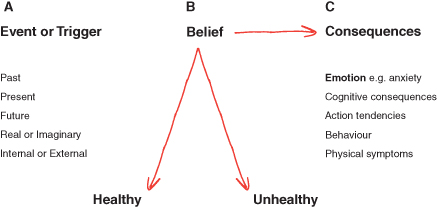
A is the event, B is the unhealthy or healthy belief you hold about A and C are the consequential responses which can be:
- Cognitive (thoughts and assumptions)
- Action tendencies (what you feel like doing)
- Behaviours (what you do)
- Emotions (anxiety, concern, depression etc.)
- Physical symptoms (blushing, heart racing etc.)
CBT is problem focused and practical – its aim is to help you get better in the long term, which is done through changing your unhealthy beliefs to their healthy counterparts. The process of change requires repetition, consistency and vigour in the application of the healthy beliefs. This means you will think and act in accordance with your healthy beliefs even though it will feel uncomfortable at first. It is completely natural as emotional change takes time and comes last after the change in thinking and behaviour. Understanding does not create emotional change. If you were to read a book on how to drive a car, understanding that does not transform you into a competent driver instantly. You would have to apply what you understand, i.e. getting into the car, accepting it will feel uncomfortable and challenging at first and mistakes can be made but by being determined and persistent you will begin to feel comfortable.
Unhealthy Beliefs
Beliefs that are unhealthy have, at their core, explicit or implicit, rigid, powerful demands, usually expressed as MUSTs, SHOULDs, HAVE TOs, GOT TOs, e.g. I absolutely must not be rejected. Unhealthy demands are not based on reality.
Rigid demands have three powerful unhealthy derivative beliefs:
Example: ‘It would be awful if I’m rejected’, ‘It would be the end of the world if I am rejected and therefore I must not be rejected.’
Example: ‘Rejection is unbearable’, ‘I can’t stand it’, ‘It’s intolerable, therefore I must not be rejected.’
Example: ‘Rejection proves I’m a failure or worthless or unlovable as a person, therefore I must not be rejected.’
These beliefs are unhealthy because they generate emotional disturbance or unhealthy negative emotions like anxiety and depression. They are unrealistic, do not make sense and are unhelpful to you. They sabotage the achievement of your goals.
The Three Major MUSTs
Albert Ellis identified the unhealthy beliefs at the heart of most emotional problems. These can be placed under three major headings. Each of these core beliefs is based on rigid demands. They are as follows:
Think of the above three core beliefs as the roots of three different trees. Each tree will then have branches and many leaves on each branch. These branches and leaves represent the many different and specific examples of the core theme. You will find, like many people, that you may have specific issues stemming from all three core beliefs.
Healthy Beliefs
Beliefs that are healthy have, at their core, preferences, usually expressed as wants and desires. They are realistic, make sense and are helpful to you in the pursuit of your goals. Preference beliefs accept the reality of what has happened, what is happening and what could happen, whether we like it or not.
Preference beliefs are expressed by:
For example: ‘I’d prefer not to be rejected but it doesn’t mean that I must not be.’ Preference beliefs lead to healthy negative emotions like concern and sadness as opposed to anxiety and depression. Anxiety and depression are provoked by unhealthy beliefs.
Preference beliefs have three powerful healthy derivative beliefs:
Example: ‘it would be bad but not the end of the world if I’m rejected.’
Example: ‘If I’m rejected, it would be difficult but I can tolerate it.’
Example: ‘I don’t like the fact that I can be rejected but I accept myself unconditionally; I’m a fallible human being who will be rejected from time to time.’
Unhealthy beliefs (Demands, Awfulising, LFT and Total Damning) are rigid, inconsistent with reality, illogical and interfere with psychological well-being.
Healthy beliefs (Preferences, Anti-awfulising, HFT and Unconditional Acceptance) are flexible, consistent with reality, make sense and promote psychological well-being.
In summary:
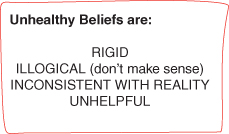

Negative Emotions
Unhealthy Negative Emotions v Healthy Negative Emotions
When we hold an unhealthy belief at B we disturb ourselves emotionally but when we hold a healthy belief at B we upset but do not disturb ourselves. Negative emotions can, therefore, be unhealthy or healthy depending on the view you take of the problem. The diagram below demonstrates this.
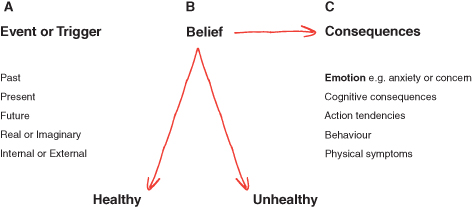
and you believe
then you will feel
then you’re feeling at
Healthy negative emotions are transient because the underlying beliefs that provoke them are rational whereas unhealthy negative emotions are not and that is why changing the underlying belief to its healthy version releases you from being stuck emotionally.
There are eight unhealthy negative emotions and eight healthy counterparts. Below is a list, the left hand column giving you the general theme for each pair.

Mixed Emotions
Often, when you have a problem you may have more than one emotion about that problem. For example, you may have experienced rejection and you may feel hurt, anxious and angry. You may feel hurt about being rejected, anxious about getting rejected again and angry about being rejected in a particular way. Each one of these emotions would be triggered by a distinct unhealthy belief.
Meta-Emotions
You can create problems about problems. This means that you can have a secondary emotional problem about your primary emotional problem. The secondary emotion is called a meta-emotion or meta-problem. For example, you can feel depressed about your anxiety problem. Depression is the meta-emotion here.
Cognitive Consequences, Action Tendencies, Behaviours
When we experience an unhealthy negative emotion or a healthy negative emotion we:
Beliefs, Cognitive Consequences, Action Tendencies and Behaviours
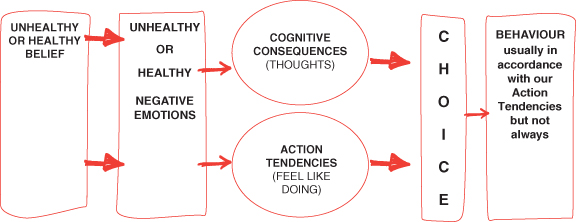
Example 1: Unhealthy Belief and its Consequences
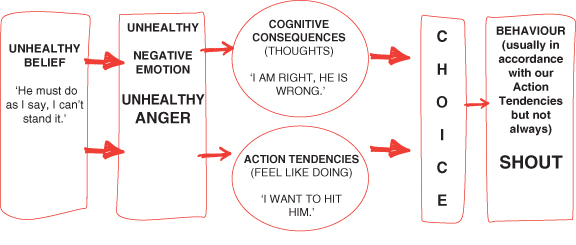
Example 2: Healthy Belief and its Consequences
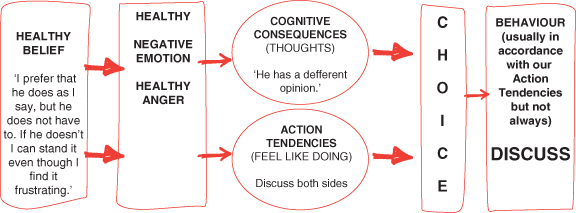
As shown by the diagrams, the cognitive consequences of unhealthy negative emotions, due to holding unhealthy beliefs, are overly negative and unhelpful. The cognitive consequences of healthy negative emotions, due to holding healthy beliefs, are constructive and helpful.
In addition to beliefs affecting your thinking processes, they also influence the way in which you tend to act (action tendencies). If you hold unhealthy beliefs about something, your action tendencies will be self defeating. On the other hand, the action tendencies will be constructive if the beliefs held are healthy.
Whether you act on the tendency is a matter of choice. Just because you may have a tendency to act in a particular way does not mean that you will always behave in that way. You can choose to behave against what you feel like doing, i.e. against your unhelpful action tendencies. In order to overcome emotional problems you need to think in a healthy way and act in accordance with the helpful action tendencies.
Now that we have covered the basics of Emotional Responsibility, we’ll explain how to use this book to help you to become more aware of your emotional state and how to take constructive action in order to move forward. The next section will explain how to use this book in detail.